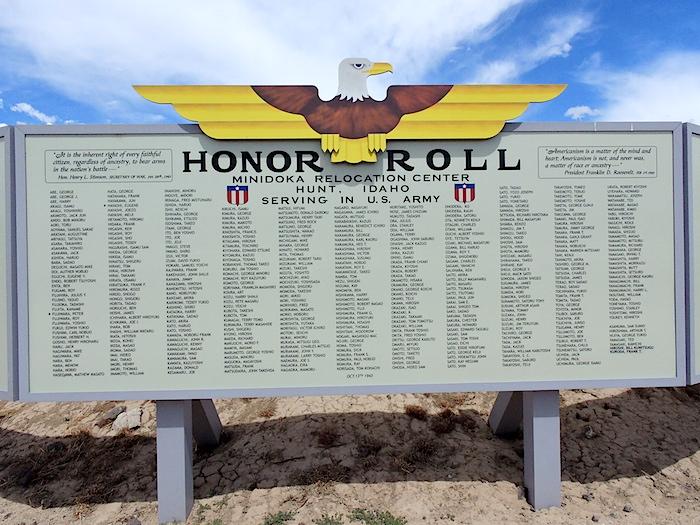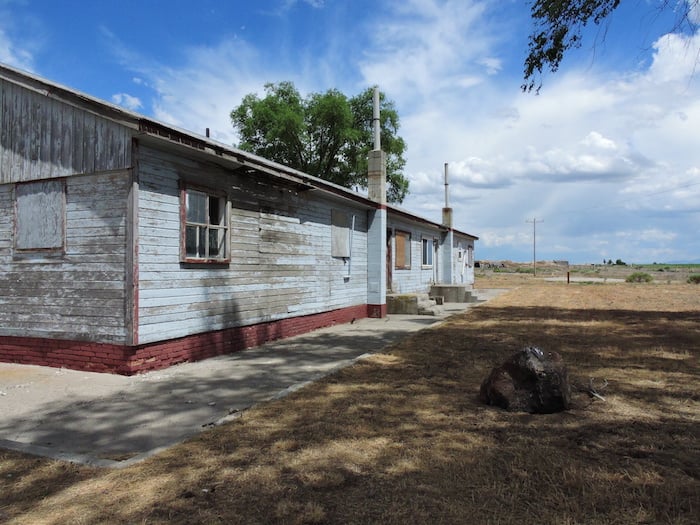It’s a winding drive through Idaho fields of corn, grain, sugar beets and potatoes. Out into the middle of a vast plain of irrigated fertility. But just 74 years ago, it was a spreading plain of sagebrush squatting beside a large irrigation canal carrying Snake River water to farms further west. It was a desolate, nearly empty place.
A perfect place for a prison camp.
Of course it wasn’t called a prison camp. No, couldn’t call it that. Internment sounded better, so it was called Minidoka Japanese Internment Camp. Just a few days after the Japanese bombed Pearl Harbor, all “enemy aliens” in California, Oregon, Washington, Montana, Idaho, Utah, and Nevada were ordered to surrender all “contraband” including short-wave radios, cameras, binoculars, and any weapons they might have.
In January and February 1942 the Selective Service – draft board – declared all Japanese-Americans to be classified as “enemy aliens” and unfit for service in the U. S. military. Large parts of the Western states became “prohibited zones” from which all enemy aliens were to be excluded.
It wasn’t just Japanese-Americans who were singled out. In some parts of the country German and Italian immigrants who had not yet become citizens joined their Japanese neighbors in being subject to curfews and travel restrictions that forbade travel more than five miles from home. And then, on February 19, 1942, President Franklin D. Roosevelt signed Executive Order 9066 that began the roundup of Japanese who lived in western states.
Forced to leave their homes and businesses and farms, tens of thousands of Japanese families were uprooted and shipped to camps with names like Manzanar, Topaz, and Minidoka. They were allowed to take only what they could carry and nothing more. Men and women, young and old, children of all ages were loaded onto buses and trains and shipped to far away places. Many were American citizens. But they were Japanese. Enemy Aliens.
Minidoka was one of those places and it was to this sage-covered landscape that 13,000 Japanese came to build and inhabit 600 buildings on 33,000 acres from August 1942 until October 1945.

There's little NPS presence at Minidoka National Historic Site/Lee Dalton
Although the order actually included people of German and Italian descent, few of them were rounded up. But Japanese . . . . well . . . . Japanese looked like Japanese. The others looked like Americans.
Internment camps consisted of hastily constructed, flimsy buildings covered with tar paper and clapboards. Wind and dust and snow often filtered into them. Hot in summer, freezing in winter. But there were army cots and pot-bellied stoves. There were schools and libraries. Sometimes there were walls around small rooms for families. But sometimes the walls were nothing more than blankets hanging from ropes or wires. Single hanging bulbs provided light. The internees were resourceful, though. They built baseball fields and gardens. Parks and picnic areas. Musical groups and newspapers. Traditional Japanese gardens.
And around it all was barbed wire and guard towers.
When finally the Army decided it just might be able to use Japanese soldiers to fight in Europe, young Japanese men joined, trained, and fought valiantly. Each camp had honor rolls posted with names of the men who served. Back in the camps, the families they left behind worked to cultivate crops. At Minidoka they built miles of irrigation canals. Many are still in use today.
The 442 Regimental Combat Unit fought in segregated units in France and Italy. The regiment, comprised almost entirely of Japanese soldiers, became one of the most highly decorated units in the United States Army for its size and time of service.
Today, Minidoka is a National Historic Site. Aside from a few battered and weathered buildings and a scattering of interpretive signs and a lonely reconstruction of a guard tower, there is nothing at Minidoka. No visitor center. I didn’t find any trail guides even though there are markers beside the buildings that indicated one might exist. Headquarters and the visitor center are miles away in Hagerman, Idaho at Hagerman Fossil Beds National Monument.
Minidoka became the 385th unit of the National Park System in 2001. Yet today, it sits lonely in a place few of us have heard of and even fewer might come to visit. I shared the place with one man from Oregon. At the VC in Hagerman, I heard a ranger lament that Minidoka is a place forgotten. “Lots of talk, but only talk and nothing happens.”
I find myself wondering. Wondering lots of things. Wondering if in this time of struggling parks if places like Minidoka should be Park Service areas. Busloads of descendants of those who were interned here visit every year. Some of those who grew up here still manage to make the trip. Should this place be turned over to some Japanese heritage organization? Could Idaho manage it? Can any other entity afford to do it? Can the Park Service afford it – even as little as it spends now?
But on the other hand, if these places are not preserved by someone, might their stories and the people whose lives were shaped here be forgotten, too?

Despite their internment, more than a few men from Minidoka enlisted to serve with the United States military during World War II/Lee Dalton



 Support Essential Coverage of Essential Places
Support Essential Coverage of Essential Places







Comments
And Texans were ridiculed for questioning the purposes of Jade Helm. Always trust your government. Ask the survivors of this camp.
We visited Minidoka a little over a week ago in early August. Although, to our surprise, a couple of NPS employees were engaged in renovating one of the barracks buildings, not another tourist showed up during what turned out to be about a two-hour visit.
I'm not certain every relocation camp needs to be under the administration of the National Park Service. We have visited California's Manzanar NHS on a couple of occasions and it does a much better job of interpreting this sorry chapter in our country's history.